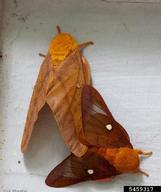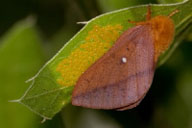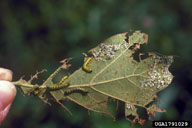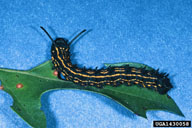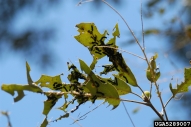Orangestriped oakworm
Anisota senatoria (J. E. Smith) (Lepidoptera: Saturniidae)
Orientation to pest
Orangestriped oakworm, Anisota senatoria (J. E. Smith), is a native silkmoth that feeds mainly on the foliage of oaks (Quercus). It has as a wide distribution in eastern United States and southern Canada. Adults appear in the June or July in the northern part of its range and lay groups of eggs on the undersides of leaves of host trees. Young larvae feed in groups, skeletonizing leaves. Older larvae consume all but the main veins and are less gregarious. Mature larvae drop to the ground and wander before pupating in the soil, where they overwinter. Outbreaks occur infrequently. There is one generation per year in most parts of the range. Defoliation can be significant in some years, but little harm results unless trees are under additional stress from other factors.
Hosts commonly attacked
This species feeds primarily on oaks (Quercus).
Distribution
This species occurs in much of the eastern United States and southern Canada, west to Minnesota and Texas, although it is not common in the southeastern United States.
Images of orangestriped oakworm
| Figure 1. Adult of orangestriped oakworm, Anisota senatoria | Figure 2. Eggs of orangestriped oakworm | Figure 3. Young larvae of orangestriped oakworm |
| Figure 4. Close up of mature orangestriped oakworm caterpillar | Figure 5. Defoliation by larvae of orange striped oakworm |
Important biological control agents related to this pest species
Parasitoids that have been reared in Virginia from orangestriped oakworm larvae or pupae include Hyposoter fugitivus (Say) (Ichneumonidae) (in larvae, 3.2 to 9.3%) and Lespesia anisotae (Webber) (Tachinidae) and Belvosia bifasciata (Fabricius) (Tachinidae)(in larvae at 10.7 and 0.7%, respectively).
Web links for information on orangestriped oakworm
- Fact Sheet | Connecticut Agricultural Experiment Station
- Guide on Species Recognition and Habits | L.L. Hyche, Auburn University
- Bulletin | Michigan State University Extension
Bulletin E-6254; provides identification and management information
